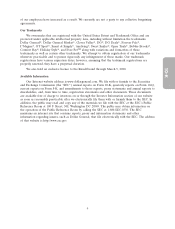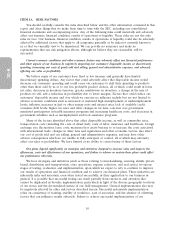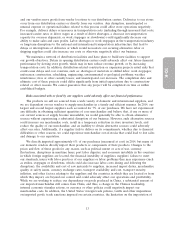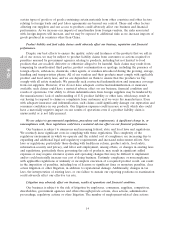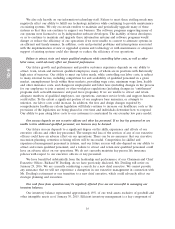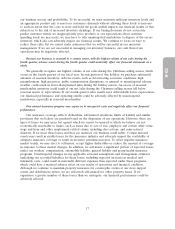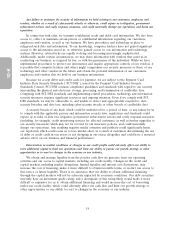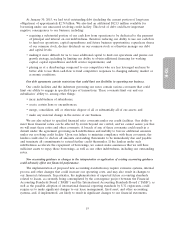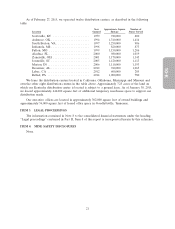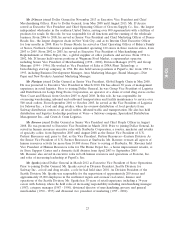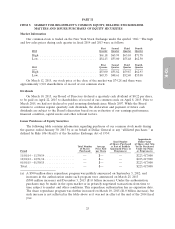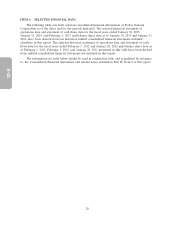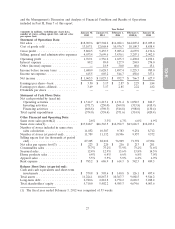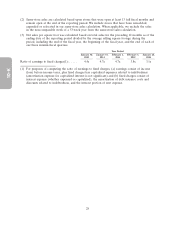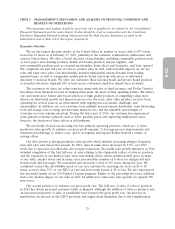Dollar General 2014 Annual Report Download - page 93
Download and view the complete annual report
Please find page 93 of the 2014 Dollar General annual report below. You can navigate through the pages in the report by either clicking on the pages listed below, or by using the keyword search tool below to find specific information within the annual report.
10-K
At January 30, 2015, we had total outstanding debt (including the current portion of long-term
obligations) of approximately $2.74 billion. We also had an additional $821.5 million available for
borrowing under our unsecured revolving credit facility. This level of debt could have important
negative consequences to our business, including:
• requiring a substantial portion of our cash flow from operations to be dedicated to the payment
of principal and interest on our indebtedness, therefore reducing our ability to use our cash flow
to fund our operations, capital expenditures and future business opportunities, repurchase shares
of our common stock, declare dividends on our common stock or otherwise manage our debt
and capital levels;
• making it more difficult for us to raise additional capital to fund our operations and pursue our
growth strategy, including by limiting our ability to obtain additional financing for working
capital, capital expenditures and debt service requirements; and
• placing us at a disadvantage compared to our competitors who are less leveraged and may be
better able to use their cash flow to fund competitive responses to changing industry, market or
economic conditions.
Our debt agreements contain restrictions that could limit our flexibility in operating our business.
Our credit facilities and the indenture governing our notes contain various covenants that could
limit our ability to engage in specified types of transactions. These covenants limit our and our
subsidiaries’ ability to, among other things:
• incur indebtedness of subsidiaries;
• create certain liens or encumbrances;
• merge, consolidate, sell or otherwise dispose of all or substantially all of our assets; and
• make any material change in the nature of our business.
We are also subject to specified financial ratio covenants under our credit facilities. Our ability to
meet these financial ratios can be affected by events beyond our control, and we cannot assure you that
we will meet these ratios and other covenants. A breach of any of these covenants could result in a
default under the agreement governing such indebtedness and inability to borrow additional amounts
under our revolving credit facility. Upon our failure to maintain compliance with these covenants, the
lenders could elect to declare all amounts outstanding thereunder to be immediately due and payable
and terminate all commitments to extend further credit thereunder. If the lenders under such
indebtedness accelerate the repayment of borrowings, we cannot make assurances that we will have
sufficient assets to repay those borrowings, as well as our other indebtedness, including our outstanding
notes.
New accounting guidance or changes in the interpretation or application of existing accounting guidance
could adversely affect our financial performance.
The implementation of proposed new accounting standards may require extensive systems, internal
process and other changes that could increase our operating costs, and may also result in changes to
our financial statements. In particular, the implementation of expected future accounting standards
related to leases, as currently being contemplated by the convergence project between the Financial
Accounting Standards Board (‘‘FASB’’) and the International Accounting Standards Board (‘‘IASB’’), as
well as the possible adoption of international financial reporting standards by U.S. registrants, could
require us to make significant changes to our lease management, fixed asset, and other accounting
systems, and, if implemented, are likely to result in significant changes to our financial statements.
19


